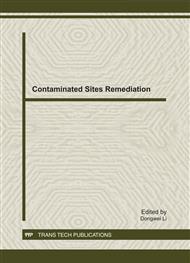p.203
p.214
p.221
p.226
p.232
p.238
p.244
p.250
p.254
Cement-Based Solidification/Stabilization of High Concentration Chromium-Contaminated Soil
Abstract:
In this paper, contaminated soil collected from chromium waste landfill has been investigated, and the cement-based solidification/stabilization (S/S) of the chromium-contaminated soil was also discussed by single-factor and orthogonal experiments. The cement can effectively solidify Cr in soil, and this can be classified into three stages: slow improvement, accelerated improvement, and technically stable limit. It is technically and economically feasible when the proportion of cement is 30%–40%. Cr (VI) dissolution can be further reduced through adding up appropriate stabilizer in the cement briquette. The results of orthogonal experiments indicate that cement proportion is the most important factor of Cr S/S, then the ratio of stabilizer, and the kind of stabilizer is the least important. In analyzing the factors of cement-based S/S of the polluted soil, the optimum parameters are as follows: the ratio of cement to soil is 35% and that of FeSO4 (stabilizer) is 2.5%. Moreover, the ultimate leaching concentration of Cr (VI) is 0.89 mg/l and curing rate is 98.27%.
Info:
Periodical:
Pages:
232-237
Citation:
Online since:
December 2011
Authors:
Price:
Сopyright:
© 2012 Trans Tech Publications Ltd. All Rights Reserved
Share:
Citation:


